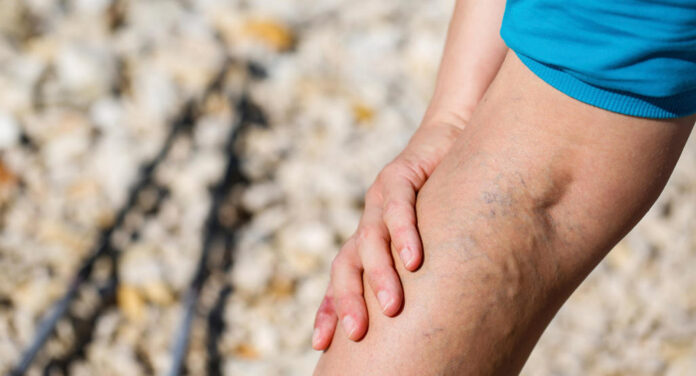Have you just taken a look at your veins and wondered why they are so blue? It’s not just you – veins have been known to mystify people for centuries. In fact, even Leonardo da Vinci was intrigued by the human body and its inner workings, and he devoted much of his time to studying anatomy.
So, why are your veins blue? The simple answer is that it has to do with the way light reflects off of your skin. But there’s a bit more to it than that.
If you wanna know all the gory details, read on. We’ll get into why veins look blue, what causes them to stand out, and how you can make them less visible. So, without any further ado, let’s get started!
Reasons Why Your Veins Appear Blue
There are many reasons why your veins might appear blue. It could be due to the way light reflects off of your skin, or it could be a sign that you have low hemoglobin levels. Here are some common reasons why your veins might appear blue:
Pregnancy or Age:
As you age, your skin becomes thinner and loses some of its elasticity. This can cause your veins to become more visible, including the blue ones. Moreover, during pregnancy, the extra blood volume can cause your veins to enlarge and become more apparent as well.
Lack of Oxygen:
If your blood is not getting enough oxygen, it will appear blue. This can be caused by several things, including lung disease, heart conditions, and anemia.
Cold Temperature:
Cold weather can cause your veins to constrict and become more visible. This is because when it’s cold, your body is trying to conserve heat, which means that the blood vessels will constrict to minimize heat loss, hence making your blue veins more visible.
Sun Exposure:
Ultraviolet light from the sun can damage the elastin in your skin, which can make your veins more visible.
Excess Weight:
If you are overweight or obese, the extra pressure on your veins can cause them to become more visibly blue. This is especially true in the case of varicose veins.
Dehydration:
If you are not properly hydrated, your blood can become thicker and put more pressure on your veins. This can cause your veins to appear bluer than usual.
Smoking:
Smoking constricts your blood vessels, which can make your veins more visible. In addition, the tar in cigarettes can discolor your skin, making your veins appear even bluer.
Treatment for Visible Veins
If you are concerned about the appearance of your veins, there are a few things you can do to reduce their visibility.
- Wear sunscreen: Wearing sunscreen can help protect your skin from the damaging effects of ultraviolet light, which can help prevent your veins from becoming more visible.
- Exercise: Regular exercise can help improve circulation and reduce the pressure on your veins. This can help reduce the appearance of blue veins.
- Avoid smoking: As we mentioned, smoking constricts your blood vessels and can make your veins more visible. Quitting smoking can help improve the appearance of your veins.
- Maintain a healthy weight: If you are overweight or obese, losing weight can help reduce the pressure on your veins and make them less visible.
- Eat a healthy diet: Eating a healthy diet rich in fiber can help improve circulation and reduce the pressure on your veins.
- Wear loose-fitting clothing: Wearing tight-fitting clothing can put pressure on your veins and make them more visible. Wearing loose-fitting clothing can help reduce the appearance of blue veins.
- Elevate your legs: If you have varicose veins, elevating your legs can help reduce the pressure on your veins and make them less visible.
- Compression stockings: Compression stockings can help improve circulation and reduce the pressure on your veins. This can help reduce the appearance of blue veins.
- Sclerotherapy: Sclerotherapy is a procedure in which a solution is injected into the vein, causing it to collapse. This can help reduce the appearance of blue veins.
Is it Something to Worry About
In most cases, blue veins are nothing to worry about. However, if you notice that your veins are suddenly more visible or that you have new veins that are blue, it is important to see a doctor to rule out any underlying medical conditions.
How to Find Blue Veins in Your Body
If you’re having trouble finding your veins, don’t worry, there are a few things you can do to find your blue veins.
- Look at your wrists: Your veins are closest to the surface of your skin at your wrists, so this is a good place to start.
- Look at your ankles: Another good place to look for your veins is at your ankles.
- Look at your neck: Your veins are also close to the surface of your skin at the neck.
- Use a flashlight: If you have trouble finding your veins, you can use a flashlight to help you see them better.
- Use a vein finder: A vein finder is a device that uses infrared light to help you see your veins. You can find these devices online or at some pharmacies. One of the best devices is the AimVein Vein Finder, this device is FDA cleared and is very accurate. You can easily find your veins with this device and it’s very affordable.
- Use a marker: Another way to find your veins is to use a marker to trace them. Once you have found your veins, you can use a pen or pencil to trace them.
Bottom Line
It’s not uncommon for people to develop blue veins, and they’re usually nothing serious. However, if you notice that your skin has a bluish tinge or new colorful patches of any kind it is important to see an experienced doctor so as avoid any underlying medical conditions from developing which might cause more harm than good in this case!
We hope this article was helpful in answering the question. If you have any further questions, please don’t hesitate to reach out to us.









